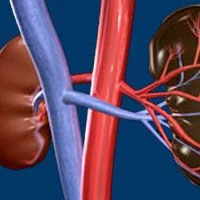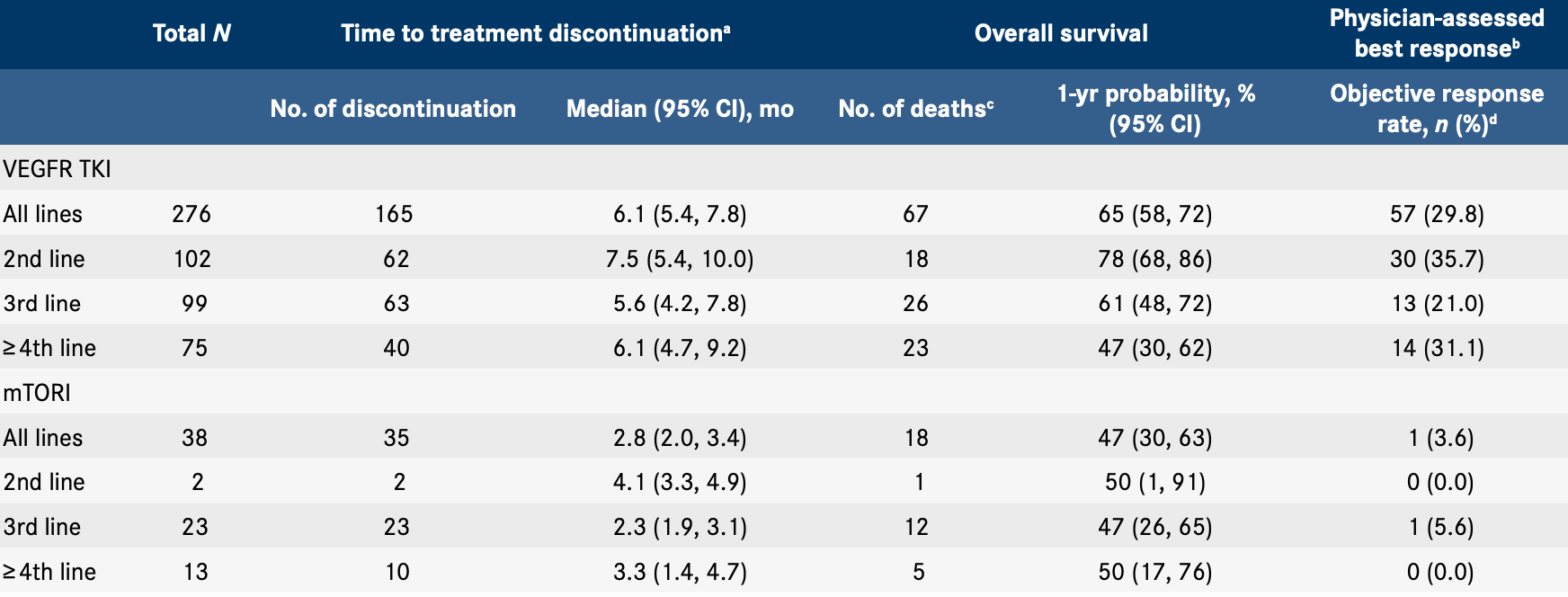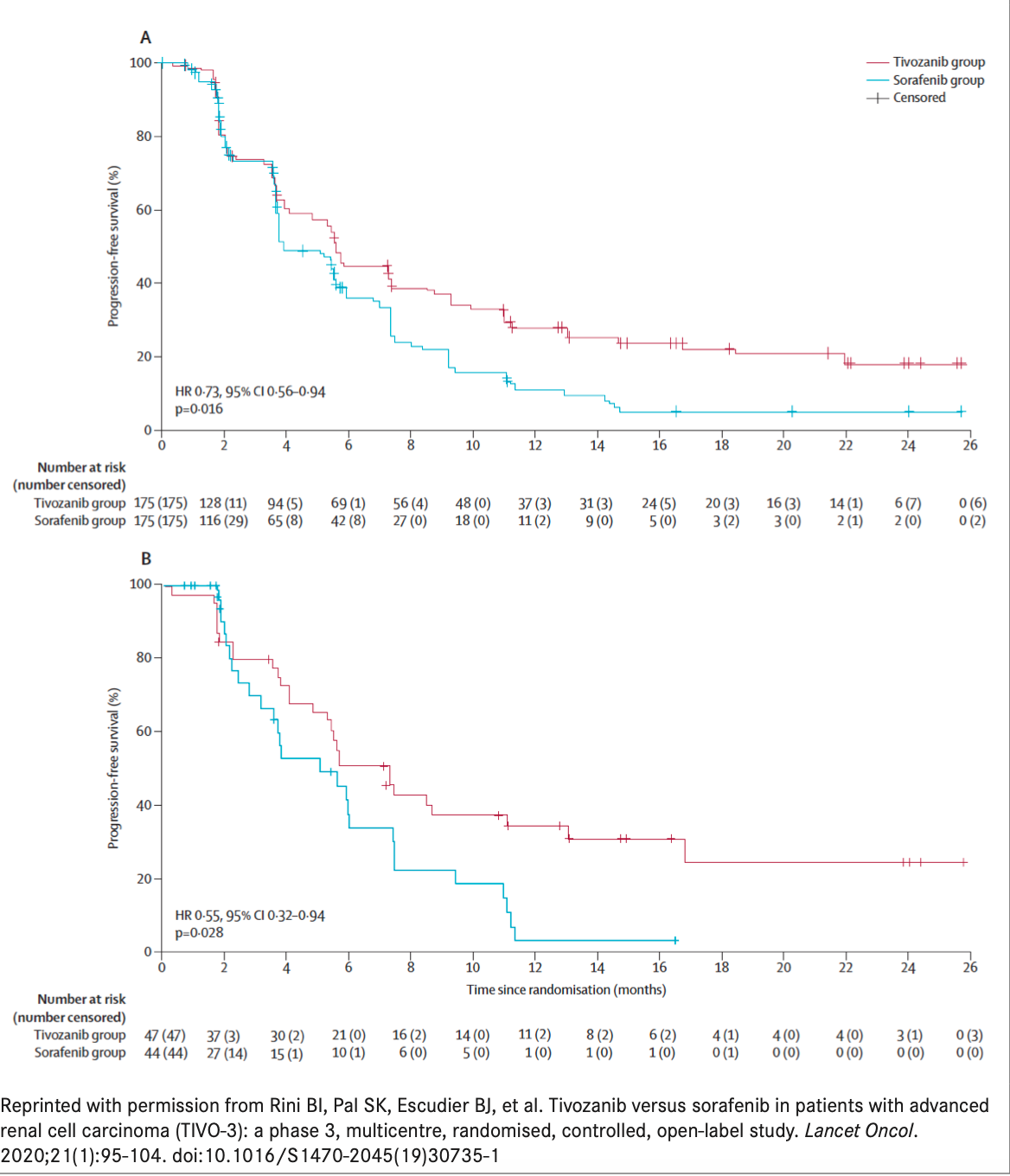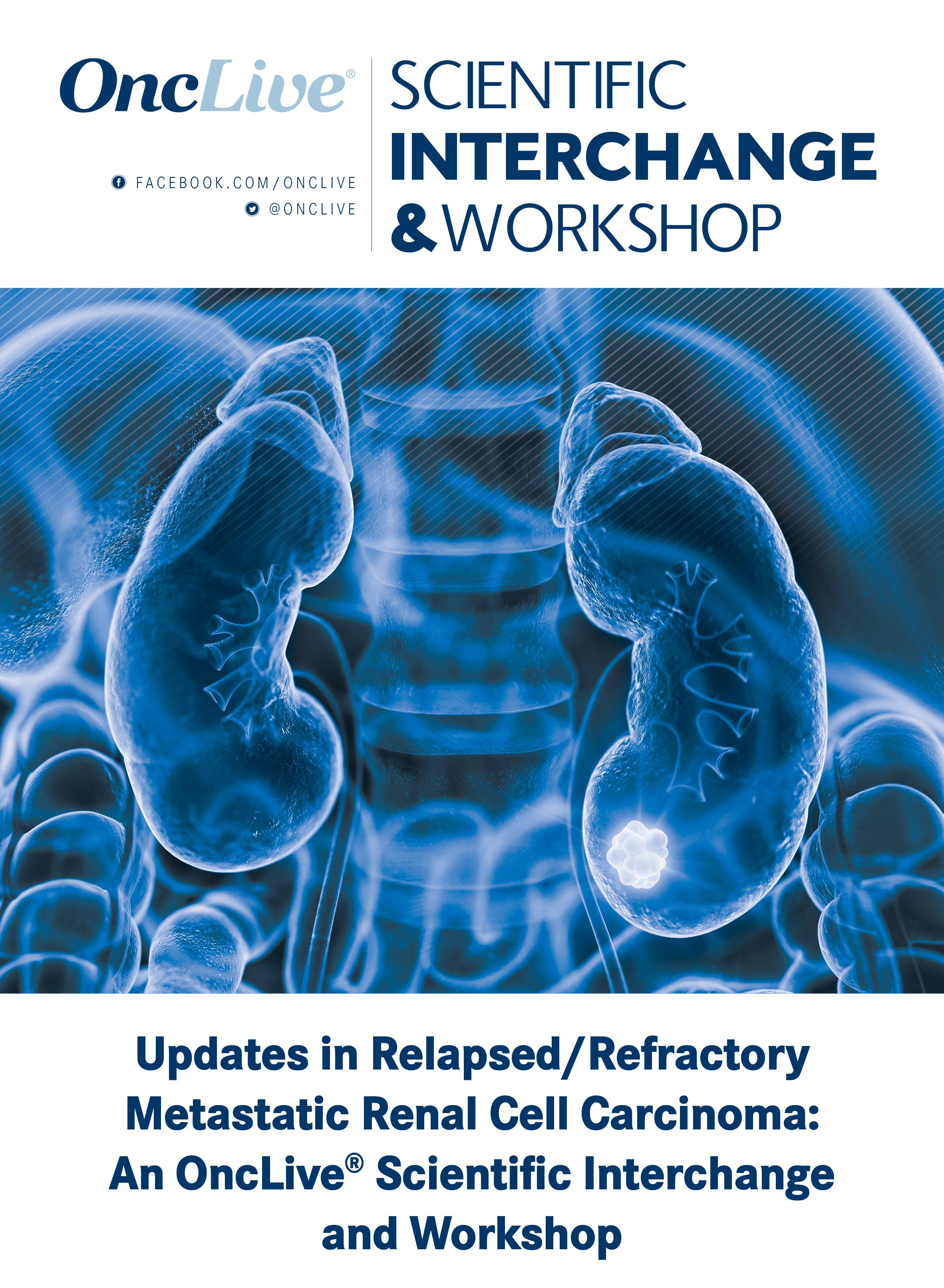Publication
Article
Supplements and Featured Publications
Updates in Relapsed/Refractory Metastatic Renal Cell Carcinoma
Targeted therapy and immunotherapy have improved survival outcomes for patients with metastatic renal cell carcinoma.

Targeted therapy and immunotherapy have improved survival outcomes for patients with metastatic renal cell carcinoma (mRCC).1 Results from an international, multi-center study of 7498 patients from the International mRCC Database Consortium (IMDC), analyzing use of several targeted therapies and an immune checkpoint inhibitor (ICI) after first-line therapy, showed that 51.4% of patients received second-line therapy, 24.2% of patients received third-line therapy, and 7.9% of patients received fourth-line therapy.1 At the time the study was published (2018), the only approved ICI for treatment of mRCC was nivolumab.1 With the approval of immunotherapies, more patients may move on to later lines of therapy, and it is important to have drugs that are active in later line settings. This article will review the current treatment recommendations for mRCC, including results from some of the larger, recent clinical trials on which the recommendations were based, and will continue with a description of other recent and ongoing trials of possible future treatments for mRCC.
Current Standard of Care
Tyrosine kinase inhibitors (TKIs) and anti-vascular endothelial growth factor (VEGF) antibodies are widely used in first- and second-line treatments for mRCC, appearing as recommended treatment in guidelines for the disease.2 Risk models may be used to evaluate treatment options.2 An example treatment algorithm from the Society for Immunotherapy of Cancer is shown in (Figure 1).2 It is an immunotherapy treatment algorithm for advanced RCC based on treatments that were approved by the FDA at the time the recommendations were published (2019) and provides guidelines for diagnostic workups, patient selection, initial therapy, and therapy for patients who are refractory.2
After first-line treatment, recommendations from the National Comprehensive Cancer Network organization for subsequent treatment of mRCC consist of fewer options for progressive disease (second-, third-, and fourth-line treatment). For patients with clear cell histology, there are 3 preferred regimens for subsequent therapy: cabozantinib or nivolumab, both of which have a category 1 recommendation (based on high-level evidence and uniform consensus within the members of the organization that the intervention is appropriate); or ipilimumab plus nivolumab, which has a category 2A recommendation (based on lower-level evidence but uniform consensus within the organization that the intervention is appropriate). Other regimens that are recommended, but not preferred, include category 1 VEGF receptor (VEGFR) axitinib or lenvatinib plus mTOR inhibitor (mTORI) everolimus, category 2A: axitinib plus pembrolizumab, everolimus, and pazopanib or sunitinib, and category 3 (based on any level evidence but with major disagreement within the organization that the intervention is appropriate) axitinib plus avelumab. Additionally, treatments that are useful in certain circumstances include VEGFR bevacizumab or sorafenib, high-dose interleukin-2 for selected patients, and temsirolimus (all category 2B, which is based on lower-level evidence but consensus within the organization that the intervention is appropriate).3
Evidence for cabozantinib includes results of the phase 3 METEOR study, which evaluated the impact of cabozantinib versus everolimus on overall survival (OS) of patients with advanced RCC. In the study, 658 patients with previously treated advanced RCC were randomized to receive either cabozantinib 60 mg every day (n=330) or everolimus 10 mg every day (n=328). Median follow-up was 28 months (interquartile range: 25, 30). Results from the study showed that median time to objective response with cabozantinib was 1.91 months (range, 1.6-11.0), versus 2.14 months with everolimus (range, 1.9-9.2). A greater proportion of patients had early tumor shrinkage (eTS) of at least 30% with cabozantinib (19.7% of patients, n=65) versus everolimus (4.9%, n=16). Additionally, the rate of any eTS was higher in the cabozantinib arm (73.3%, n = 242) than in the everolimus arm (47.3%, n = 155), and the percentage of patients with no eTS was lower in the cabozantinib arm (23.3%, n=77) than in the everolimus arm (47.6%, n=156). For patients with at least 30% eTS, median OS was not reached (NR) (95% CI, 23.7-NR) for those receiving cabozantinib, versus 10.2 months (95% CI, 3.9-not evaluable [NE]) for those receiving everolimus (stratified HR, 0.45; 95% CI, 0.21-0.95; P =.05). For patients with any eTS, median OS was 23.7 (95% CI, 21.7-27.7) for those receiving cabozantinib, versus 17.3 months (95% CI, 15.4-20.8) for those receiving everolimus (stratified HR, 0.62; 95% CI, 0.48-0.80; P = .05). For patients with no eTS, OS was similar between the 2 groups.
The phase 3 CheckMate 025 trial demonstrated superior OS with nivolumab for previously treated patients with advanced RCC compared with everolimus.5 An updated final analysis with a minimum follow-up of 64 months was reported.5 In the study of 821 patients with previously treated predominantly clear cell advanced RCC, patients were randomized to receive nivolumab 3 mg/kg intravenously (IV) every 2 weeks (n = 410) versus everolimus 10 mg orally once daily (n = 411). The primary end point was OS, and secondary end points were objective response rate (ORR), progression-free survival (PFS), and safety. At more than 5 years of minimum follow-up, response rates and survival were superior with nivolumab compared with everolimus. Median OS was 25.8 months (95% CI, 22.2-29.8) for patients receiving nivolumab versus 19.7 months (95% CI, 17.6-22.1) for patients receiving everolimus (HR, 0.73; 95% CI, 0.62-0.85).
Figure 1. Society for Immunotherapy of Cancer Recommendations2
OS at 60 months was 26% for the nivolumab group versus 18% for the everolimus group.5 Median PFS per investigator was 4.2 months (95% CI, 3.7-5.4) in the nivolumab group versus 4.5 months (95% CI, 3.7-5.5) for the everolimus group (HR, 0.84; 95% CI, 0.72-0.99). PFS at 60 months was 5% of patients receiving nivolumab versus 1% of patients receiving everolimus. ORR per investigator was 23% (95% CI, 19-27) in the nivolumab group versus 4% (95% CI, 2-7) for the everolimus group (odds ratio, 6.86 [95% CI, 4.01-11.74]). Complete response was experienced by 4 patients (1%) in the nivolumab group versus 2 (0.5%) in the everolimus group. Median duration of response (DOR) was 18.2 months (95% CI, 12.9-25.8) for the nivolumab group versus 14.0 months (95% CI, 8.3-19.2) in the everolimus group.5 Ongoing responses were observed in 28% of patients (26 of 94) receiving nivolumab versus 18% of patients (3 of 17) receiving everolimus.5
Table. Treatment Outcomes Among Patients Treated With VEGFR TKIs and Those Treated With mTORIs After IO Treatment6

Therapeutic Sequencing
Research has also been conducted on other targeted and immuno-oncology (IO) therapies, including sequencing for second-line VEGF therapies after first-line ICIs. A retrospective, longitudinal cohort study of VEGF therapy after treatment with an ICI was undertaken using data from 8 international cancer centers. The study evaluated adult patients with mRCC who received IO therapy in any line (including second, third, fourth, or higher) and then initiated targeted therapy after discontinuing IO therapy (TABLE).6 Interventions were VEGFR TKIs (which include axitinib, bevacizumab, cabozantinib, pazopanib, sorafenib, and sunitinib) or mTORIs (which include everolimus and temsirolimus). Outcome measures were time to treatment discontinuation (TTD), OS, and ORR. The study included 314 patients; 276 received VEGFR TKIs and 38 received mTORIs. Median TTD among patients treated with VEGFR TKIs or mTORIs after IO treatment was 6.1 months (95% CI, 5.4-7.8) for all lines of VEGFR TKIs and 2.8 months (95% CI, 2.0-3.4) for all mTORI lines. OS 1-year probability was 65% (95% CI, 58-72) for all lines in patients treated with VEGFR TKIs and 47% (95% CI, 30-63) in all lines for those receiving mTORIs. The ORR was 29.8% (n = 57) for all lines of those treated with VEGFR TKIs and 3.6% (n = 1) in all lines for those treated with mTORIs.6
Second-line VEGF therapy after first-line ICI treatment was also studied in a medical record review that analyzed patients with mRCC treated with nivolumab plus ipilimumab who received a subsequent VEGFR TKI (n = 33) as part of the CheckMate 214 study (NCT02231749). Outcome measures were PFS, OS, and toxicities. PFS from second- line therapy was significantly longer when the duration of nivolumab plus ipilimumab was at least 6 months (PFS of 8 months for responders of at least 6 months versus 5 months for responders of less than 6 months (P = .03). OS for the study population was 54% after 12 months and 37% after 24 months. Grade 3 and 4 adverse events (AEs) were experienced by 14 patients (42.4%).7
Future Trends and Opportunities: Additional Potential Treatments Ahead
Additional treatments for mRCC are continuing to be studied, as described in the following section. The evolving treatment landscape includes treatments such as further VEGFR TKI therapy, combination therapy such as lenvatinib plus pembrolizumab, hypoxia-inducible factor (HIF) inhibitor, and a multikinase inhibitor with an ICI.
Tivozanib
Tivozanib is a novel VEGFR TKI that is already approved by the European Medicines Agency for first-line treatment of adults with RCC. With a half-life of 4 to 5 days, tivozanib is designed to optimize the VEGFR blockade while minimizing off-target effects. The phase 3 TIVO-1 trial (NCT01030783) evaluated tivozanib versus sorafenib for first-line treatment of mRCC. Results showed that PFS was 11.9 months for patients receiving tivozanib versus 9.1 months for patients who received sorafenib (HR, 0.797; 95% CI, 0.639-0.993; P = .04). OS favored sorafenib, in which just 13% of patients (34 of 260) who received tivozanib were given subsequent targeted therapy, compared with 63% of patients (162 of 257) who received sorafenib. Additionally, tivozanib showed activity among patients who received the treatment after sorafenib (median PFS of 11.0 months [95% CI, (7.3–12.7)] and OS of 21.6 months [95% CI, (17.0–27.6)] from the start of treatment).8
In this pivotal phase 3 trial evaluating tivozanib in heavily pretreated patients, TIVO-3 compared the efficacy and safety of tivozanib versus sorafenib in patients with advanced RCC that have progressed after multiple systemic therapies.8 Key eligibility criteria were that patients had been diagnosed with advanced clear cell RCC; had failed 2 or 3 prior regimens, including at least 1 VEGFR TKI (1 of which was not tivozanib or sorafenib); and had an Eastern Cooperative Oncology Group performance status of 0 or 1. Prior regimens could have been a VEGFR TKI and ICI, 2 VEGFR TKIs, or a VEGFR TKI and 1 other therapy. Patients were also stratified by the IMDC risk categories of favorable, immediate, and poor. Patients were randomized to tivozanib 1.5 mg orally once daily (21 days on, 7 days off per cycle) (n = 175) or sorafenib 400 mg orally twice daily (continuously in a 28-day cycle) (n = 175) until treatment progression or unacceptable toxicity. The primary end point was PFS, and secondary end points were OS, ORR, DOR, and safety.8
In the TIVO-3 trial, a significant reduction in the risk of progressive disease was observed for tivozanib versus sorafenib in the intention-to-treat (ITT) population (HR 0.73, 95% CI 0.56–0.94; P = .016) and in 1 of the study subgroups, patients previously treated with an ICI and VEGFR TKI (HR 0.55, 95% CI 0.32–0.94; P = .028). FIGURE 2 shows estimated PFS in both study populations.8 Median PFS in the ITT population (n = 350) was 5.6 months for patients receiving tivozanib (95% CI, 5.29-7.33) versus 3.9 months for those receiving sorafenib (95% CI, 3.71-5.55) (HR, 0.73; 95% CI, 0.56-0.94; P = .016). For patients who received a prior ICI plus a VEGFR TKI (n = 91), median PFS was 7.3 months (95% CI, 4.8-11.1) in the tivozanib group versus 5.1 months (95% CI, 3.2-7.4) in the sorafenib group (HR, 0.55; 95% CI, 0.32-0.94). For patients who received 2 prior VEGFR TKIs (n = 159), median PFS for patients receiving tivozanib was 5.5 months (95% CI, 3.6-7.4) versus 3.7 months (95% CI, 3.6-3.9) for patients receiving sorafenib (HR, 0.58; 95% CI, 0.4-0.8).8 In the IMDC favorable risk group, median PFS for patients receiving tivozanib was 11.1 months (95% CI, 7.4-14.6) versus 6.0 months (95% CI, 3.7-7.5) for sorafenib (HR, 0.46; 95% CI, 7.4-14.6). In the IMDC intermediate risk group, median PFS for patients receiving tivozanib was 5.6 months (95% CI, 4.8-7.4) versus 5.5 months (95% CI, 3.7-6.8) for sorafenib (HR, 0.69; 95% CI, 4.8-7.4). In the IMDC poor risk group, median PFS for patients receiving tivozanib was 2.1 months (95% CI, 1.8-3.5) versus 3.7 months (95% CI, 2.0-3.7) for sorafenib (HR, 1.15; 95% CI, 1.8-3.5).8
For the secondary end point in the TIVO-3 trial, OS between tivozanib and sorafenib groups were similar.8 Median OS in the ITT population was 16.4 months (95% CI, 13.4-22.2) for patients receiving tivozanib versus 19.7 months (95% CI, 15.0-24.2) for patients receiving sorafenib (HR, 0.99; 95% CI, 0.76-1.29; log-rank P = .95). However, significantly more patients achieved a response with tivozanib than with sorafenib.8 ORR (secondary end point) was 18% (n = 31) for the tivozanib group (95% CI, 12-24) versus 8% (n = 14) for the sorafenib group (95% CI, 4-13).8 Median duration of response (secondary end point) was NR in the tivozanib group (95% CI, 12.9-NR) and 5.7 in the sorafenib group (95% CI, 5.6-NR).8
Tivozanib appeared to be well tolerated with AEs consistent with what has been previously reported.8 Serious treatment-related AEs (TRAEs) occurred in 19 (11%) of patients receiving tivozanib and 17 (10%) of patients receiving sorafenib. Fewer dose interruptions (83 [48%] vs 107 [63%]) and dose reductions (41 [24%] vs 65 [38%]) due to AEs occurred for patients receiving tivozanib than for those receiving sorafenib, respectively.8 The most frequent AEs leading to treatment discontinuation were the following: malignant neoplasm progression, which affected 3% (n = 5) of patients receiving tivozanib and 1% (n = 2) of patients receiving sorafenib; and fatigue, which occurred for 1% (n = 1) of patients receiving tivozanib and 4% (n = 6) of patients receiving sorafenib. No TRAEs resulted in death in either treatment group.8
Additionally, real-word results have been reported for tivozanib. Tivozanib was approved in Europe in August 2017.9 The University of Munich reported the results of a retrospective analysis of a prospective database, including data from 23 patients undergoing tivozanib treatment between November 2017 and November 2018. Median PFS was 14.9 months (95% CI, 5.1-24.8). Regarding tumor response, 9 patients (39.1%) had a partial response, 12 (52.2%) maintained stable disease, and 2 (8.7%) experienced progressive disease. Median duration of therapy was 12.5 months (range, 2.3-30.6). No new safety signals were detected.9
ORR at week 12 (n=91) was 51% (95% CI, 39.9-61.2). Disease control rate (complete response + partial response + stable disease; n = 91) was 91% (95% CI, 83.4-96.1).10 Median DOR (n = 91) was 9.9 months (95% CI, 6.9-NE). Median time to response (TTR; n = 91) was 1.6 months (range, 1.2-7.6 months). Median PFS (n = 103) was 11.7 months (95% CI, 9.5-NE). The most common TRAEs were fatigue (49% of patients), diarrhea (44%), and proteinuria (37%). There was one grade 5 TRAE (upper gastrointestinal hemorrhage), and 43% of patients required dose reduction. TRAEs were responsible for discontinuation by 12% of patients.10
Figure 2. Kaplan-Meier Estimated Progression-Free Survival in (A) the Intention-to- Treat Population and (B) a Subgroup of Patients Who Had Been Previously Treated With a Checkpoint Inhibitor and a Tyrosine Kinase Inhibitor8

Lenvatinib Plus Pembrolizumab
In another effort to investigate possible treatments for mRCC, a phase 2 study of lenvatinib plus pembrolizumab after ICI therapy was initiated.10 The trial was a multicenter, open-label study of patients with clear cell mRCC who experienced progressive disease during or after ICI therapy. Patients were treated with lenvatinib 20 mg orally once daily plus pembrolizumab 200 mg IV every 3 weeks. The primary end point was ORR. In the study population, 58% of patients had at least 2 prior anticancer regimens, and 91 of 104 patients were evaluable for response at week 12. At data cutoff (January 12, 2020), 69% of patients (n = 71) were still on the study treatment.
ORR at week 12 (n=91) was 51% (95% CI, 39.9-61.2). Disease control rate (complete response + partial response + stable disease; n = 91) was 91% (95% CI, 83.4-96.1).10 Median DOR (n = 91) was 9.9 months (95% CI, 6.9-NE). Median time to response (TTR; n = 91) was 1.6 months (range, 1.2-7.6 months). Median PFS (n = 103) was 11.7 months (95% CI, 9.5-NE). The most common TRAEs were fatigue (49% of patients), diarrhea (44%), and proteinuria (37%). There was one grade 5 TRAE (upper gastrointestinal hemorrhage), and 43% of patients required dose reduction. TRAEs were responsible for discontinuation by 12% of patients.10
HIF Inhibition: MK-6482
Hypoxia is a key characteristic of solid tumors. Tumor adaptation to hypoxia is associated with an aggressive phenotype and poor prognosis. Adaptation to hypoxia is mediated by HIFs. HIFs regulate the expression of target genes that promote angiogenesis, glycolysis, metastasis, increased tumor growth, and resistance to treatments. The HIF-2α transcription factor is a key oncogenic driver in clear cell RCC. HIF-2α is present in highly vascularized organs and hypoxic tissues, such as kidney epithelial cells. Between 50% and 80% of patients with clear cell RCC have an inactivated von Hippel-Lindau (VHL) gene, the gene that normally mediates expression of HIF-2α.11
HIF-2α pathways allow clear cell RCC to proliferate in a variety of ways. HIF-2α pathways include VEGF-α, which drives angiogenesis, along with GAS6/AXL, CXCR4/SDF1, and MET, which encourage metastasis. HIF-2α pathways also include TGF-α/EGFR signaling, c-Myc, cyclin D1, SLC7A5, and mTORC1, which facilitate the clear cell RCC cell cycle and proliferation. Other HIF-2α pathways include glucose transporter-1, through the pentose phosphate pathway, and antioxidant enzymes, which provide resistance against oxidative stress. HIF-2α pathways also include the mitochondria biogenesis factors carnitine palmitoyltransferase 1A and perilipin 2, which lead to reduced mitochondrial content, lipid accumulation, and resistance against endoplasmic reticulum stress.12
MK-6482 is a first-in-class small molecule inhibitor of HIF-2α that blocks heterodimerization of HIF-2α with HIF-1β. In a phase 1/2 study of MK-6482 in patients with previously treated advanced RCC (n = 55), patients received MK-6482 120 mg once daily. The primary end point was safety, and key secondary end points were ORR, DOR, and PFS. The most common grade 3 AEs were anemia (26%) and hypoxia (15%). There were no grade 4 or 5 drug-related AEs. As of May 15, 2019, 30 patients (55%) discontinued due to progressive disease, and 2 (4%) discontinued due to AEs. ORR was 24%, median DOR was NR, and median PFS was 11.0 months.13
Additionally, an open-label, phase 2 study was conducted of MK-6482 for treatment of VHL-associated clear cell RCC in adults with pathogenic germline VHL variation and no prior systemic anticancer therapy (n = 61). The treatment regimen consisted of MK-6482 120 mg orally once daily. The primary end point was ORR, and key secondary end points were DOR, TTR, PFS, safety, and tolerability. ORR was 27.9% (95% CI, 17.1-40.8). DOR was NR (range, 2.1-9.0 months). TTR was 5.5 months (range, 2.7-14.0). Median PFS was NR; the 12-month PFS rate was 98.3%.14 The most common grade 3 AEs were fatigue (4.9%) and anemia (3.3%).14
Sitravatinib
Inhibition of receptor tyrosine kinases (RTKs) has direct biological activity against advanced clear cell RCC. The process enhances immunotherapy by reducing immunosuppressive regulatory T cells, myeloid-derived suppressor cells, and type 2 tumor-associated macrophages. The RTK inhibitor sitravatinib is a multikinase inhibitor that targets TAM receptors (Tyro3, Axl, MerkTK), split family receptors (VEGFR2 and c-KIT), and c-Met. Results have been reported from a phase 1/2 trial of sitravatinib with nivolumab in patients with advanced clear cell RCC that progressed after up to 2 prior VEGF-targeted therapies. Tumors included mRCC with a clear cell component and progressive disease after VEGF treatment. Four sitravatinib dose levels were included in the trial: 60, 80, 120, and 150 mg per day. Results demonstrated median PFS of 10.5 months (95% CI, 7.6-13.5). The most common TRAEs included fatigue, diarrhea, palmar-plantar erythrodysesthesia, hypertension, and elevated lipase. One grade 5 TRAE was reported, myasthenia gravis, which was related to nivolumab.15
Conclusions
The evolution of targeted therapy and immunotherapy has the potential to improve the treatment of mRCC. Targeted therapy and immunotherapy have improved survival outcomes for patients with mRCC. Clinical trials are ongoing to assess the safety and effectiveness of therapies that may further improve the current standard of care. Tivozanib has demonstrated favorable outcomes in phase 3 trials and may prove to be an important therapy for patients who are relapsed or refractory to multiple lines of therapy. Additional agents and combinations in clinical trials in which additional data are forthcoming also have the potential to affect the treatment landscape further.
References
- Stukalin I, Wells JC, Fraccon A, et al. Fourth-line therapy in metastatic renal cell carcinoma (mRCC): results from the International mRCC Database Consortium (IMDC). Kidney Cancer. 2018;2:31-36. doi:10.3233/KCA-170020
- Rini BI, Battle D, Figlin RA, et al. The Society for Immunotherapy of Cancer consen- sus statement on immunotherapy for the treatment of advanced renal cell carcino- ma (RCC). J Immunother Cancer. 2019;7(1):354. doi:10.1186/s40425-019-0813-8
- NCCN. Clinical Practice Guidelines in Oncology. Kidney cancer, version 1.2021. Accessed October 1, 2020. https://www.nccn.org/professionals/physician_gls/pdf/kidney.pdf
- 4. Duran I, Maroto P, Suárez C, et al. Analysis of overall survival (OS) based on earlytumor shrinkage in the phase III METEOR study of cabozantinib (cabo) versus everolimus (eve) in advanced renal cell carcinoma (RCC) [ASCO abstract 550]. J Clin Oncol. 37(suppl 7):550. doi:10.1200/JCO.2019.37.7_suppl.550
- Motzer RJ, Tykodi SS, Escudier B, et al. Final analysis of the CheckMate 025 trial comparing nivolumab (NIVO) versus everolimus (EVE) with >5 years of follow-up in patients with advanced renal cell carcinoma (aRCC) [ASCO abstract 617]. J Clin Oncol. 2020;38(suppl 6):617. doi:10.1200/JCO.2020.38.6_suppl.617
- Graham J, Shah AY, Wells JC, et al. Outcomes of patients with metastatic renal cell carcinoma treated with targeted therapy after immuno-oncology checkpoint inhibitors. Eur Urol Oncol. 2019;S2588-S9311(19)30160-9. doi:10.1016/j.euo.2019.11.001
- Auvray M, Auclin E, Barthelemy P, et al. Second-line targeted therapies after nivolumab-ipilimumab failure in metastatic renal cell carcinoma. Eur J Cancer. 2019 Feb;108:33-40. doi:10.1016/j.ejca.2018.11.031. Erratum in: Eur J Cancer. 2019;119:200-201
- Rini BI, Pal SK, Escudier BJ, et al. Tivozanib versus sorafenib in patients with advanced renal cell carcinoma (TIVO-3): a phase 3, multicentre, randomised, controlled, open-label study. Lancet Oncol. 2020;21(1):95-104. doi:10.1016/ S1470-2045(19)30735-1
- Staehler M, Spek AK, Rodler S, et al. Real-world results from one year of therapy with tivozanib. Kidney Cancer. 2019;3:235-239. doi:10.3233/KCA-190073
- Lee CH, Shah AY, Hsieh JJ, et al. Phase II trial of lenvatinib (LEN) plus pembrolizumab (PEMBRO) for disease progression after PD-1/PD-L1 immune checkpoint inhibitor (ICI) in metastatic clear cell renal cell carcinoma (mccRCC) [ASCO abstract 5008]. J Clin Oncol. 2020;38(suppl 15):5008. doi:10.1200/JCO.2020.38.15_suppl.5008
- Cuvillier O. The therapeutic potential of HIF-2 antagonism in renal cell carcinoma. Transl Androl Urol. 2017;6(1):131-133. doi:10.21037/tau.2017.01.12
- Meléndez-Rodríguez F, Roche O, Sanchez-Prieto R, Aragones J. Hypoxia-inducible factor 2-dependent pathways driving von Hippel–Lindau-deficient renal cancer. Front Oncol. 2018;8:214. doi:10.3389/fonc.2018.00214
- Choueiri TK, Plimack ER, Bauer TM, et al. Phase I/II study of the oral HIF-2 α inhibitor MK-6482 in patients with advanced clear cell renal cell carcinoma (RCC) [ASCO abstract 611]. J Clin Oncol. 2020;38(suppl 6):611. doi:10.1200/JCO.2020.38.6_suppl.611
- Jonasch E, Donskov F, Iliopoulos O. Phase II study of the oral HIF-2α inhibitor MK-6482 for Von Hippel-Lindau disease–associated renal cell carcinoma [ASCO abstract 5003]. J Clin Oncol. 2020;38(suppl 15):5003. doi:10.1200/JCO.2020.38.15_suppl.5003
- Msaouel P, Thall PF, Yuan Y, et al. A phase I/II trial of sitravatinib (sitra) combined with nivolumab (nivo) in patients (pts) with advanced clear cell renal cell cancer (aCCRCC) that progressed on prior VEGF-targeted therapy [ASCO abstract 612]. J Clin Oncol. 2020;38(suppl 15):612.










